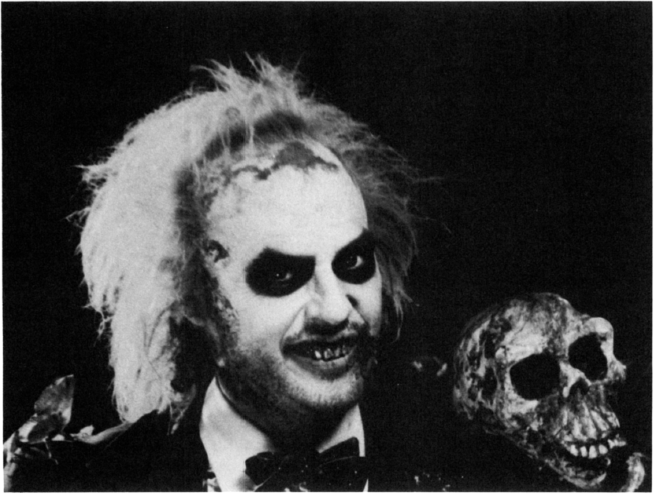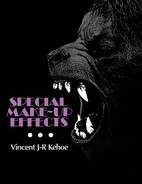CHAPTER 2
Special and Popular Characters
MYTHOLOGY, MODERN AS WELL AS ANCIENT, HAS INFUSED a myriad of popular conceptions and fantasies into human thought. Some are stylized, popular, and happy characters that have become part of our life as well as entertainment, while others have drawn upon our dark imaginations and hidden fears to instill a different element to which many are drawn out of curiosity and desire to see the unknown.
HORROR CHARACTERS
Perhaps the misty world of spirits and demons offers the greatest scope for the imagination, and make-up artists’ conceptions have opened avenues of thought, sometimes heretofore inconceivable in frightening aspects and elements. Certainly, advancing technology and research in the field have produced more realistic and startling effects and creatures year after year, and it seems that the public not only dotes on these imaginative films but also supports the trend by contributing huge box office returns to the producers. Motion pictures have expanded the scope and depth of the horror style of entertainment far beyond what was possible on any stage in the past. Today, and in the future, we will see even more thrillingly terrifying films with the use of electronic and other spectacular tools of the engineers as well as the visual creations of the make-up artist. Special effects have entered many fields including not only make-up but also lighting, filmic superimposition, musical accompaniment, and other related crafts and arts.

FIGURE 2.1 Lon Chaney, Sr., in The Phantom of the Opera in a make-up that inspired many young make-up artists of the 1940s to attempt to copy. This was a classic horror make-up done with old nose putty, facial distortion, false teeth, a bald front wig, and strong highlights and shadows. (Universal’Pictures.)
Silent films introduced Lon Chaney and his many characterizations and special make-ups (Figure 2.1). Lon Chaney, Jr. told the story that his father kept his make-up/dressing room closed to everybody, and when he had to make repairs or changes, filming stopped and he went alone into his sanctum, emerging only when he was satisfied that his appearance was as he wanted it to be. Father passed no secrets down to son, and much of his art and craft died with him.
By the 1930s, studios had formed make-up departments that were mainly concerned with beautifying the performers until Jack Pierce of Universal Studios was faced with creating a Monster for the film Frankenstein (Figures 2.2 to 2.5). His creation commenced a trend that still leads the box office: the fantasy-horror film.
Although the early “horror” make-ups were done laboriously with old-time materials, later re-creations employed latex pieces that are far easier on the performer and can be pre-prepared for use. For example, The Mummy make-up had a complicated cloth wrapping on the body covered with a glue and dusted with Fuller’s Earth to simulate a decaying body, while the same effect was later created with a grayed latex base paint covering a pre-made costume.
Other horror style make-ups such as Dracula were done with a gray-green foundation, very dark red lips and the eyes outlined to appear deep and penetrating

FIGURE 2.3 Universal’s make-up artist Jack Pierce created the make-up with a headpiece made of cloth, cotton batting, spirit gum, and collodion. (Universal Pictures.)
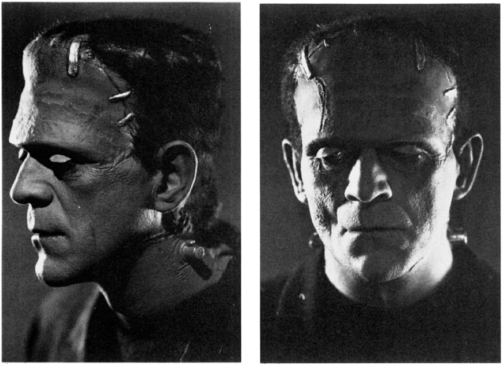
FIGURE 2.4 So strong was Karloff’s portrayal that audiences began to call the Monster “Frankenstein” rather than the evil doctor who created the creature in the film! ( Universal Pictures. )
(Figure 2.6). Mr. Hyde, the alter ego of Dr. Jekyll, has gone through many phases from the John Barrymore one, to that of Frederic March, Spencer Tracy, and Louis Heyward; and to the more modern ones often seen in revived productions today (Figure 2.7).
Two of Rick Baker’s horror make-ups include the decaying corpse sequence in An American Werewolf in London, which was done with foamed latex appliances on the actor (Jack Stave), showing the destruction on the side of the face and neck by the claws of the werewolf that had attacked him (Figure 2.8). The slush molded latex mask made for the same film for one of the Nazi demons shows the detail of the sculpture to demonstrate the decay the mask was supposed to convey (Figure 2.9).
Although not really in the horror make-up category, distortions of the human body that are startling to the eye, such as the recreation of the terribly disfiguring disease known as neurofibromatosis that afflicted a man named Jon Merrick during the last part of the nineteenth century, can be grouped in this classification. When Merrick died at age 27, his body and face were so distorted by the ravages of the illness that he was quite unrecognizable as a human being.

FIGURE 2.6 Other famous make-ups were those created by Jack Dawn: (A) Dracula for Bela Lugosi; (B) The Mummy and (C) The Wolfman, both for Lon Chaney’s son (who hated to be called “junior” after his father died!), all in films for Universal Studios, which seemed to monopolize the horror film field at that time. (Universal Pictures.)
To create this effect for the Paramount Pictures film The Elephant Man starring John Hurt, Christopher Tucker studied the actual photos and even a cast taken of the head and shoulders of Merrick that are the property of the London Hospital. It was found, however, that the actual distortions of the jaw and cheek lines were so radical that if the prostheses that he would make for the actor were to match the actual features, they would be impossible to apply on a normal face. Tucker therefore produced distortions so that the actor could still articulate his lines, and yet retain the pathet- icism that was required for the audience to have sympathy for the poor creature rather than be just horrified by the effect.
In designing the project, Tucker had to break down the make-up appliances into sections. Due to the thickness required in some facial areas where joins are normally made, he designed the make-up in two levels. That is, he had appliances that were under the outer ones.
On a face cast of the actor, he first sculpted his concept of the completed Elephant Man. Then, on a separate facial cast, he modelled the underlying sections, made molds, and cast these in silicone rubber.
Outer sections were molded separately, overlapping each to match the skin texture. The head was made in two sections, the face in fifteen, and the right arm was made in three—hand and wrist, elbow joint, and the upper arm. The upper torso was built in nine sections, some of them being up to four inches thick in places. Due to the exigencies of the shooting schedule, the molds were made in triplicate, and so it took long hours for eight weeks to prepare them.
Although most of the appliances were made of foamed latex, the two head sections were made of polyurethane foam with a latex skin into which hair was inserted, hair by hair, and, being more durable, were used a number of times (see Figure 2.10). A urethane foam made by Dow Corning was employed for a number of the sections.

FIGURE 2.7 Frederic March as Mr. Hyde in the Paramount Pictures production ( 1932) of Dr. Jekyll and Mr. Hyde, the most exciting version of this much filmed story. Note the painted nostrils, overpainted mouth, false teeth, and shadows and highlights make-up along with extra brows and a low-browed hairpiece. {Paramount Pictures.)
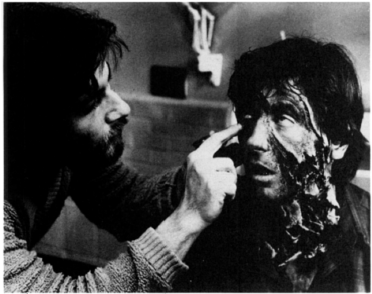
FIGURE 2.8 Rick Baker’s horror make-up for the decaying corpse sequence in An American Werewolf in London. (Polygram Pictures, 1980.)
The make-up took some six hours to apply during the production, and due to the long make-up time as well as the long shooting day, John Hurt worked only every other day. The actor’s patience as well as the make-up artist’s skill resulted in a classic make-up and a remembered film. The point was made once more that regardless of how skilled a performer may be, unless the actor “looks” the part, the audience loses much of its empathy for the character being portrayed (see Figure 2.11).
SKULLS AND SUPERNATURAL CHARACTERS
Always related to horror is the fear of necromancy, demons, and devils that pervades all cultures to some degree. Bones and skulls induce the fear of death and destruction, and the image of the Devil might take many forms, but all of them are basically evil. Figure 2.12 shows a skull make-up done with black-and- white foundations in a carefully drawn replica of the human skull on the face. A black, hooded costume completes the overall effect.

FIGURE 2.9 A slush molded latex mask made for one of the Nazi demons in An American Werewolf in London. (Rick Baker photo.)
Figure 2.13 shows conventional devil make-up with horns, small moustache and pointed goatlike beard, and upturned eyebrows and eyes. The hairstyle or a skull cap provides a standard effect as do the pointed ears. Facial colors range from red to green or even a natural shade.
Witches are weird, mysterious, not-quite-human women that are portrayed in many ways in films and television (Figures 2.14 and 2.15). Shakespeare’s Three Witches in Macbeth are classic examples of these creatures that make excellent study vehicles, and makeup artists should always attempt to make them as different as possible. Such have long hooked or flat, shapeless noses and chins; thin, wrinkled, or overly distended lips; missing or blackened teeth; straggly brows and hair; and the skin from a dull yellow or greenish tone to possibly purplish color often covered with moles, hair, or dirt. Cracked and blackened or long, curved, sharp fingernails on thin, bony, ugly hands with large knuckles are generally in order.
The beautiful variety of witches or those portraying the evil women in Dracula’s castle should be cold but exotic, forbidding yet compulsively exciting, and always sensual to the point of which no one can refuse whatever they desire of one (Figure 2.16). Blood-red lips set in pale, translucent skin with green or purple eye make-up and long hair can add to their filmy costumes and gliding walk.
Mephistopheles, in Gounod’s opera Faust, is one of the most popular conceptions of the devil character. He has been portrayed in many different ways and with various foundation colors—such as greenish tones, red, or even a fluorescent make-up have been used. The overall feeling of the make-up should display a diabolical intent and extreme maliciousness unless the script calls for these qualities to be hidden until the moment of exposure. Hands may have long nails in black or green, with the color being the same as the face. They might be shadowed and highlighted to appear long and delicately bony. Human nature is steeped in the lore that devils and witches are evil in intent, and the make-ups may be asked to reflect this.

FIGURE 2.11 (a) and (b) John Hurt, before and after make-up. (Photos courtesy Christopher Tucker.)
ANIMAL-PEOPLE CREATURES
Some of these creatures are created to be horrible, like the Wolfman of Jack Pierce, while others are the benign Lion created by Jack Dawn on Bert Lahr for the MGM production of The Wizard of Oz (Figure 2.17). One of the first major uses of foamed latex for appliances, the make-ups in this film have become works of enduring excellence. Also see page 32.
Bob O’Bradovich designed the make-up on Richard Burton, shown in Figure 2.18, for the NBC TV production of The Tempest. The clip-on fangs were never used because they impeded the actor’s speech. See section on Tooth Plastics for tooth casts and construction.
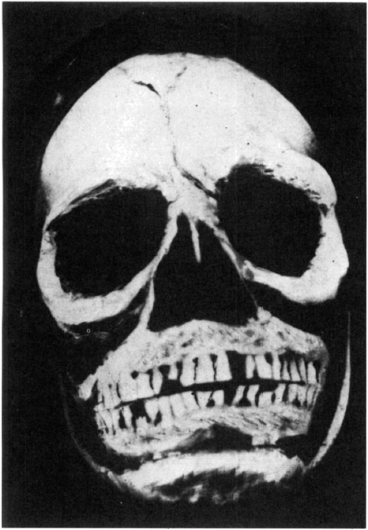
FIGURE 2.12 A skull make-up.

FIGURE 2.13 Devil make-up.
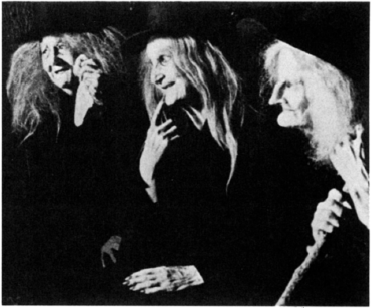
FIGURE 2.14 Witches. Three witches with make-up by the author on three older actresses. The facial effect was enhanced by asking them to remove their dental plates. (Carl Fischer Studios!make-up by the author.)

FIGURE 2.15 Witches. The hooked, warted nose and chin, straggly hair and brows, wrinkled features and discolored skin typify the concept of the ugly witch. The eyes can be bleary and bloodshot or small and piercing. Blackened teeth also help.
John Chambers’s make-ups in The Planet of the Apes made an unusual script idea into a spectacular production with his chimpanzee, gorilla, and orangutan creatures (Figure 2.19). Although the extras had slush molded heads, the principles and speaking apes had foam latex pieces that consisted of sections for the upper face, lower lip, chin, and so on. Many of the pieces were precolored before application, and foundation was used to blend in the edges. Much facial hair and head hair also aided in disguising the edge of the appliances. The performers’ faces had their own teeth and lip areas blackened out, and many had false teeth (of the ape creatures) inserted into the appliances. This was a first in making performers into truly believable animal creatures, and what could have been a laughable B-grade picture, turned out to be a film classic solely due to the design of the appliances to allow the performers a means of making expressions that were almost human on animal features. A foamed latex from the Goodyear Rubber Company was used in making the pieces on many of the characters.
However, the man who carried the ideas of making a man to animal to unusual dimensions is Rick Baker. As a very young man, he was obsessed with the idea of producing a gorilla creature that was completely believable and ended up in the animal suit himself to make the characterization complete. He even played the most famous gorilla in screen history in the color film version of King Kong as well as many other commercial and feature films.
Before the project of making a full ape culture for the film Greystoke, for which enormous undertaking he had a complete lab-workshop-studio built in England—a project that took him two years of incessant work to complete, aided and encouraged by ex-wife Elaine (who ran all his foamed latex for him)—he had accumulated a vast knowledge of the primates and other animal creatures and won the first regular Academy Award for make-up for his spectacular An American Werewolf in London (see Figures 2.8 and 2.9). One of the projects that worked out many of the methods for producing facial expressions on oversize heads and body conformations and ease in replacing fragile parts for the suits of hair was for the film The Incredible Shrinking Woman—again, with Rick playing the gorilla and his wife pulling the strings (Figures 2.20 and 2.21).
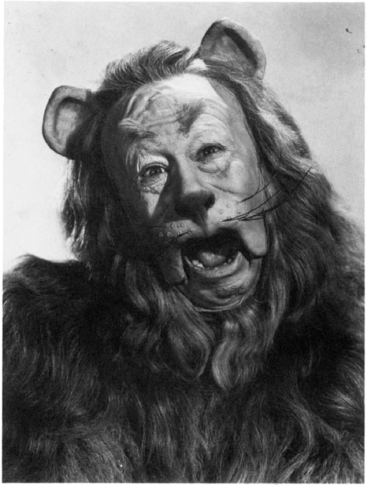
FIGURE 2.17 The Cowardly Lion of Bert Lahr in MGM’s Wizard of Oz. (Courtesy MGM Pictures.)

FIGURE 2.18 Richard Burton as Caliban in The Tempest.

FIGURE 2.19 John Chambers’s extraordinary make-up for The Planet of the Apes (20th Century Fox—1967) gained him a special Academy Award for making the apes so lifelike and completely practical in use for the performers to create characters the audience could believe fully. Without this credibility, the effect could have been ludicrous. (Courtesy John Chambers. )
The operation of the facial expressions in the gorilla mask were far beyond what a performer could do with his own face pressing against any part of the mask, so a series of devices was required to activate these. Again, it becomes evident that even though a performer actually does the role in make-up (even though it is a full or partial covering of the face at times), if mechanical devices improve the performance, are they not a part of the make-up?
In The Incredible Shrinking Woman, Rick played the gorilla Sidney and we see in Figure 2.20 the complexity of the costume he constructed. In the center is the knotted hair suit with its sponge rubber chest. The heads in front of this are the close-up head, the “hoot” head, and the “roar” head—designed to form the various expressions that gorillas employ—while to the left is a slush molded head, and above it a fake fur suit for stunt men to wear. In the boxes are the dextrous mechanical extension hands (four pairs in case of damage to the hands during filming), while surrounding are various hand and foot positions to be exchanged on the suit for various attitudes of the appendages. Extra heads, hands, and feet for replacements are also seen as are various simian skulls in the upper left that were used for research to sculpture.
For Greystoke, Rick improved the simian suits to an amazing degree of reality (Figure 2.22). First, he drew sketches of the apes, giving each its own facial features and personality traits distinguishable from each other. Next, sculptures were done over the performers’ life masks to follow the sketches. Note the similarity of the drawing of the character Figs with the sculpture at the lower left.


FIGURE 2.21 On set with wife Elaine and special effects technician Guy Faria, Rick is in the Sidney suit with the close-up head. Note the multiple cables that produce the movements in the headpiece. As the feet were not being filmed here, Rick wore comfortable shoes! ( Courtesy Universal City Studios and Rick Baker.)
For the film, these ape characters were developed extraordinarily by Rick Baker, as can be seen in the ape Silverbeard (played by Peter Elliot) as he first appears and then later in the film showing an aged character (Figure 2.23). This is an unusual instance where make-up has been employed to age an animal character played by an actor.

FIGURE 2.22 LEFT: Drawing of character “Figs.” RIGHT: Clay sculptures of characters. “Figs” lower left. (Photos courtesy Warner Bros. Pictures and Rick Baker. )
Each ape character in Greystoke had four heads: a close-up head that was cable operated and capable of changing expressions from, for example, eating to licking lips (however, the performers supplied the jaw movements and the eyes were covered with full scleral lenses); a “roar” head to snarl and show teeth activated by the performers’ movements; a “hoot” head that made a pursed lip expression; and a stunt head of slush latex filled with polyfoam (Figure 2.24). The suits were hand knotted onto a lycra spandex base body stocking that was stretched over a muscle suite made of lycra spandex with varying densities of foam muscle formation, rib cages, and other bone structures. As well, there were various hands and feet that were interchangeable (Figure 2.25).
Once again, the art of make-up and the genius of those who can achieve the likenesses of both humans and animals becomes the entire point—of the plot, the story, the script, the action, the characters, and direction of that portion of the film. Without the make-up, it would make so much dumb show by competent performers—and no one has union-organized simians as yet to perform quite as such!
Not to be outdone in the animal-men gender, Stan Winston came up with his “Manimal” transformation for the television series of the same name (Figure 2.26). His unusual method of going beyond the simple facial cast of a performer to sculpting a full head in plastalene of the expression he wants to depict demonstrates his artistic ability and desire to make his creations as lifelike as possible. Working with a series of close-up photographs and measurements in addition to a life mask, he inserts teeth and eyes into the sculpture to visualize his conceptions. In the case of the “Mammal,” this snarling expression is seen reflected in all the stages of the transmutation from man to black panther (Figure 2.27).
FANTASY TYPES
Fairies, elves, sprites, nymphs, and other fanciful characters can be done in an impressionistic style. Fairies can be made up straight and pretty in light shades of foundation, while elves, sprites, and the like should be done in light shades of brown or green to resemble forest colors. They can have small pointed noses and ears. Somewhat similar are leprechauns, although the foundation shade can be normal while the ears and nose can be pointed. Upturned brows and a small unkempt wig will add to the effect (Figure 2.28).
Within the fantasy types one can include such makeups as might be found in Alice in Wonderland (Figure 2.29), Shakespeare’s A Midsummer Night’s Dream, The Wizard of Oz (Figures 2.30 and 2.31), and similar productions on stage or for the screen (Figures 2.32, 2.33, 2.34, and 2.35). Again, foamed latex or urethane appliances will see wide use to depict the characters.
Also related to fantasy types might be included humanoid robot creations like the one Stan Winston devised and made for the film Heartbeeps, with Bernadette Peters and Andy Kaufman playing the two characters (Figure 2.36). To achieve the necessary translucence and artificiality and to produce a new look for the make-up, Stan Winston employed a gelatin mixture for the appliances and intrinsically colored them with gold for Aqua, the female, and bronze for Val, the male robot. The latter had 12 separate pieces, and Aqua had 6. The coloration was delicately and carefully done using silver as highlights, so no extrinsic color or foundation was required on the appliance, only on the exposed skin areas. Matte adhesive was used to adhere the pieces, but being the material they were, they required constant attention. The make-ups were nominated for the Academy Award as being innovative and unusual in concept.

FIGURE 2.24 White Eyes is shown with his roar head, showing the fine detail in the facial portion of the foamed latex head, the teeth in the mask, and the scleral contact lenses on the actor s eyes.

FIGURE 2.25 Figs on set in the foreground with Kala, Tarzan’s ape- mother, and on the left, a tiny latex rubber Tarzan. The other apes are background characters whose suits and heads are as carefully made as the principles’ costumes. Figs is seen with his relaxedmode feet and dextrous mechanical arms that extended the performer’s arm proportions but still allowed him to manipulate the fingers and pick up things.

FIGURE 2.26 Stan Winston, sculpting the Manimal progressions from man to black panther. Final sculptures are on right.
DOLLS, TOYS, AND TIN SOLDIERS
Within the range of fantasy and children’s stories are found playthings come to life (Figure 2.37). Light shades of foundation, with stylized cheekcolor circles, drawn red lips, accented eyelash make-up, and drawn brows are suitable here. Any make-up done for chil dren’s stories should avoid any effect that might be frightening and should induce children to cuddle the toy rather than be afraid of it.
STATUARY
A marble effect can be obtained by first covering the skin with a white foundation and then carefully giving the skin reflectivity with a pearl foundation. A plastic or latex cap is used over the hair or a very stiff wig, sprayed with white and the same pearl for translucence.
Gold or bronzed statuary can be simulated with gold, bronze, or copper foundations. Gold, white, and other colored hairsprays (Nestle) can also be used on the skin, or the old method is to use a mixture of gold or bronze bronzing powder, with glycerin, water, and alcohol as a vehicle. This is then applied with a large silk sponge in a thin coat on the body. Care should be taken with the latter as it can block the skin pores, so the entire body should not be covered to allow breathing space for the skin.

FIGURE 2.27 Stan Winston’s Manimal sculpture of the commencing facial expression of Simon MacCorkindale taken from the photo below it on the left, and a stage in the transformation with make-up appliances on the right showing the progression of the idea and the expression. The on-screen transformations included the use of various bladder inflation effects and film superimposition as well as make-up changes in tight close-up from man to black panther.

FIGURE 2.28 Roddy MacDowall as a leprechaun in CBC-TV General Electric Theatre. (Make-up by the author.)

FIGURE 2.29 Bobby Clark as the Duchess in NBC-TV’s Alice in Wonderland with a complete foam latex face by Dick Smith.
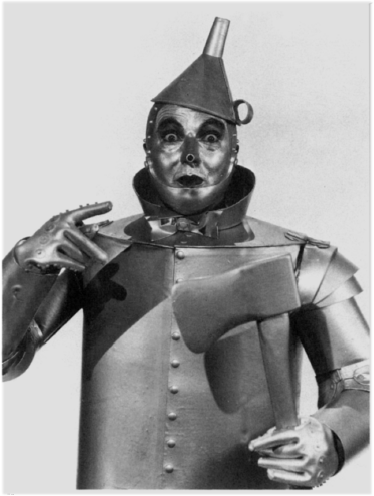
FIGURE 2.31 Jack Haley as the Tin Man in the same film. Although much of the effect is costume, the silver painted face and spout nose was very effective along with the head and chin pieces. (Courtesy MGM Pictures. )

FIGURE 2.32 Two of Stan Winston s make-ups for the film, The Wiz, showing the application of a stylized beak-nose prosthesis, and the completed Lion make-up, showing a different concept from that of the earlier Wizard of Oz film (Universal!Motown, 1978).

FIGURE 2.34 “Old Father Time” is another fanciful character that must be far more decrepit than “Santa Claus. ” Long, white hair, a drawn face, and a long, whispy beard typify this make-up.
SURREALISTIC MAKE-UPS
The world of surrealism is wide and varied, and many different aspects and directions can be taken with makeups to express the craft and imagination of the artist. Some employ flower petals around the eyes, others use sequins, while some design with color.
Rock singers sometimes employ such fantastic makeups as contributory to the imagery they wish to convey. Originality in application, design, and placement of colors on the face or hair gives free reign to the imagination. However, once the concept is established, it becomes an intrinsic part of the singer or group, and to copy such exactly by another person or persons is often considered to be a breach of theatrical etiquette— just as it is for specific clown make-ups in the circus. Nevertheless, certain forms exist that seem to establish a framework or create a style indigenous to the person or group.

FIGURE 2.35 Bob Schiffer of Walt Disney Studios created this pumpkin head on Jonathan Winters for a Disney Halloween Special with a slush and paint-in molded head in two sections with the inside fit made of polyurethane foam.

FIGURE 2.37 Toy soldier.

FIGURE 2.38 Barton MacLane in RKO Pictures, The Spanish Main ( 1945) in a typical pirate make-up. Note the scars on the cheek and forehead, the unshaven beard effect, and the added drawing of the eyebrows along with the period wig.

FIGURE 2.40 Whiteface and tramp clowns, LEFT: Felix Adler in the whiteface make-up he made famous, CENTER: Paul Jerome as The Tramp. RIGHT: A classic whiteface clown, Jackie Le Claire.
PIRATES
Most pirates should be dark, swarthy characters who seldom shave and often have scars on their faces to add to their ferocity (Figure 2.38). KM-8, KT-3, KT-4, or K-3 are foundations that may be used. Eye patches, hairy arms and bodies, and straggly, unkempt hair are typical. The pirate crew should always be interspersed with Negroid and Mongoloid types, and appropriate foundations should be used.
CLOWNS
Basically, professional clowns divide their make-ups into the whiteface and the tramp. The typical whiteface uses a clown white or Super White that is powdered with a white powder or prosthetic base powder (Figure 2.39). Red, blue, green, and black shades are used to create the designs and accentuate the features. Many clowns employ ordinary china marking pencils for the colors as these are easy to sharpen by unraveling the paper covering. Copying the face or special markings by another clown is considered to be a serious breach in circus etiquette, so unless one is copying a specific clown character, new designs are always called for in design.
Facial hair is seldom used—unless just painted on for Keystone Kops or beard effects. A skull cap can be made from a white stocking and pulled over the head. Earholes can be cut when the cap is centered. Wigs with bald fronts and red hair are often seen. Red latex noses (slush molded, usually) are special clown features and can be made in various shapes.
The tramp clown variety can be made happy or sad, depending upon the turndown or turnup of the mouth drawing. Here the unshaven beard effect is almost always used, and the face can be made up with light to medium shades of foundation to set it off. Mouths can be white or red. The costume is always of the old clothes variety, seldom fitting anywhere and exaggerated whenever possible.
There have been many famous clowns from the Barnum and Bailey Circus; among them were Emmett Kelly and Paul Jerome as tramps and, in whiteface, Felix Adler, who always wore a rhinestone on the end of his nose (he called it an Irish Diamond, or a sham rock) and always led a baby pig on a string for his walkaround (Figure 2.40). Other famous whiteface clowns include Jackie LeClaire, Al White, Ernie Burch, A1 Bruce, Arnie Honkola, and many others.
Another phase of this type of make-up is practiced by mimes. However, this is mainly a white face with few other markings, and the neck is seldom painted, leaving a rather masklike look to the make-up.
FIRST SPECIAL ACADEMY AWARD FOR MAKE-UP—1964
A landmark in make-up artistry was established when William Tuttle, then head of the MGM make-up department, won the Academy Award for make-up artistry for the Galaxy-Scarus/MGM film, The Seven Faces of Dr. Lao. Combining every form of character makeup procedure, along with foamed appliances, special hair and head dresses, and the coordinated costumes for each character, these multiple make-ups on a single face will forever remain a goal for other artists to accomplish.
A pre-make-up photo of Tony Randall (Figure 2.41) serves to enforce and delineate these changes in the characters portrayed. The first test of the Dr. Lao old oriental was done with a plastic bald cap, but as this is a time-consuming and annoying daily procedure (to the actor as well as the make-up artist), and as Dr. Lao was a main character, Tony agreed to shave his head. All the other parts required various wigs anyway (Figure 2.42).
Dr. Lao required foamed latex appliances over and under the eyes to produce the epicanthic fold of oriental eyes. An appliance was also added to the nose to broaden it. Hairlace brows, moustache and beard, and small frame glasses added to the effect. Additional aging was done with stipple and painting.
Making the facial structure of one race appear to be that of another must take into careful consideration the structural appearances of the performer and what must be added, or subtracted, to produce the desired effect. Bill had the experience of producing the Asian lid make-up on Marlon Brando for Teahouse of the August Moon for MGM in 1956, and employed the same technique for converting an African-American woman to a Geisha. This latter make-up was done during the period of filming of the Teahouse. Ebony Magazine had requested (for a special article) that he do an unusual transformation on the woman. Rather than do an old age make-up as suggested, and having the Geisha wigs and costumes available from the film, he was inspired to do this spectacular transformation. It proved to be so convincing that she was accepted as a visitor from Japan when she visited the Teahouse set (Figures 2.43– 2.44).
Continuing on the Dr. Lao make-ups, the character “Pan” was done with a new nose, new eye make-up, brows, moustache and beard, and a wig with balsa wood horns along with a dark make-up base (Figure 2.45).

FIGURE 2.41 Tony Randall, no make-up.

FIGURE 2.42 Tony Randall as Dr. Lao.

FIGURE 2.44 Before and after Geisha make-up.
“Appolonius of Tyana” consisted of again a different nose, beard, moustache, brow, and wig with a light- colored make-up foundation along with blue corneal lenses for the eyes (Figure 2.46).
“Merlin the Magician” called for more nose and hair changes, deep aging with make-up and stipple effects, and pale blue corneal lenses to accent the age level (Figure 2.47).
“Medusa” had foamed appliances over the eyes. To produce a smooth facial appearance, appliances were made to fill in Mr. Randall’s facial structure. Both upper and lower lips of foamed latex produced a more feminine appearance. Lips were painted green and green corneal lenses were used on the eyes. The MGM Special Effects Department made and animated the snakes in the hair piece (Figure 2.48).
“The Abominable Snowman” make-up was a large foamed prosthesis with balsa wood teeth. The skin was made a pinkish hue and dark circles were painted around the eyes. The tongue of the actor was painted with powdered charcoal for an effect. Although the body suit was made of synthetic fur, the wig was made of the skins from Colobus monkeys, using only the white portion of the fur (Figure 2.49).

FIGURE 2.46 Tony Randall as Appolonius.

FIGURE 2.47 Tony Randall as Merlin the Magician.

FIGURE 2.48 Tony Randall as Medusa.

FIGURE 2.50 Peter Boyle as the Frankenstein monster.
The seventh face was not make-up but a Serpent produced by the MGM Special Effect Department (every studio had one in those days).
WILLIAM TUTTLE S FRANKENSTEIN “MONSTER”
As everyone who does make-up “wants” to do a Frankenstein “Monster”, Bill Tuttle did this make-up on Peter Boyle in MGM’s hilarious spoof with Gene Wilder in 1974 (Figure 2.50). Although foam rubber was utilized on the forehead and the housing of the zipper on the neck, along with hairlace side pieces, most of the make-up effect was done with highlighting and shading procedures. Mel Brooks, the director, had heard that the original “Monster” make-ups done by Jack Pierce at Universal Studios had employed a greenish foundation, so he asked Bill to do the same for the make-up (even though it was to be shot in B&W film). Bill obliged and did the shadows in dark green and the highlighting with yellowish-green. The missing tooth was done with black tooth enamel.
